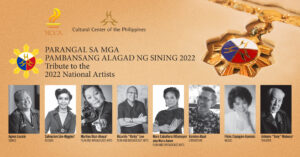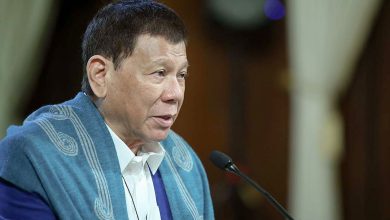CCP, NCCA pay tribute to new National Artists

THE EIGHT new National Artists for 2022 were honored with at a tribute ceremony at the Cultural Center of the Philippines on June 29.
In attendance were National Artist for Dance Agnes Locsin; National Artists for Film and Broadcast Arts Nora Villamayor (a.k.a Nora Aunor) and Ricardo “Ricky” Lee; and National Artist for Literature Gemino Abad. National Artist for Music Fides Cuyugan-Asensio participated via a video message Posthumous awardees Antonio “Tony” Mabesa, National Artist for Theater, Salvacion Lim-Higgins (a.k.a. “Slim”), National Artist for Fashion Design, and Marilou Diaz-Abaya, National Artist for Film and Broadcast Arts, had family and student representatives present on their behalf.
The program — hosted by Tanghalang Pilipino actor Marco Viaña and actress Irma Adlawan — featured performances of the new National Artists’ works including Abad’s poem, “Jeepney,” recited by Shamaine Centenera-Buencamino; “Mabini’s Lament,” an excerpt from the ballet La Revolucion Filipina choreographed by Locsin; an excerpt from Mabesa’s Fake; the song “Napakahaba ng ng Gabi” from the opera La Loba Negra, with lyrics by Fides Cuyugan-Asensio and performed by soprano Katrina Saga; a montage of scenes from the films Brutal, Karnal, Moral, and Himala, which were works by Diaz Abaya, Lee, and Aunor; and songs from the Himala The Musical, adapted from one of Aunor’s tour de force, Himala, performed by Aicelle Santos with the Manila Symphony Orchestra.
NATIONAL ARTIST GEMINO ABADIn his speech, writer, critic, scholar, literary historian, and anthologist Mr. Abad stressed that “any work of art is work of language and imagination.”
“For the artist, language is his muse, and imagination is his guide. Language is not only words. The word is our way, truth, and life,” said Mr. Abad — who has received the Don Carlos Palanca Memorial Awards for his poetry, the CCP Award for Poetry, the Ani ng Dangal Award, and the Gawad Alagad ni Balagtas for lifetime achievement in poetry and literary criticism. “All our words speak true. The nature or being of a word is truth. Only the liar and the author of fake news corrupts language and degrades his own nature.”
NATIONAL ARTIST SALVACION LIM-HIGGINSSalvacion Lim-Higgins — known for transforming the look of the terno by combining the elements of the Philippine dress with European couture details, and who founded the Slim’s Fashion & Arts School in 1960 — was represented by her son, Mark Higgins, who received the award on her behalf.
He noted how great art is considered timeless.
“Observing her work while I was growing up is what made me realize that fashion is actually both an art and a craft. Art lies in the vision and the craft is in application. The art is the dream, the craft is in making it real,” Mr. Higgins said.
“In creating a garment, she would apply two elements to her process: architecture and sculpture,” he said. “The architecture would surface into the building of the form — the scaffolding, engineering to support this masterpiece. Always thinking in three dimensions, her final touch would be molding and manipulating the fabric onto the human form transforming the wearer into an element human sculpture.”
NATIONAL ARTIST FIDES CUYUGAN-ASENSIOProfessor Emeritus Fides Cuyugan-Asensio’s career in music and musical theater spans over six decades. While performing, teaching, producing, and directing opera and theater productions, she contributed to a Renaissance of classical musical theater in the country. She was the former Chairman of Voice and Music Theater Department at the UP College of Music.
In her video message, Ms. Asensio said that her colleagues in music had made several attempts over 12 years to have her be named National Artist. Three professors in the UP College of Music had worked to turn in materials on her career in music for her nomination.
“Personally, I was not aware of what they were doing or what they had done until suddenly there was a deluge of wishes congratulating me for being National Artist for Music,” Ms. Asensio said. “To God be the glory, thank you,” she said, and ended her message by singing a portion of “Quando M’en Vo” from La Bohème by Giacomo Puccini.
NATIONAL ARTIST AGNES LOCSINA choreographer, director, and teacher, Agnes Locsin is known for her neo-ethnic dance choreography. Among her works are Babaylan, which won second place in the Tokyo International Choreography Competition in 1993; and Salome which won second place for dancer Camille Ordinario in the 1994 Concours International de la Danse in Paris, France.
Ms. Locsin recalled sitting in the last row of the CCP’s Main Theater with her friends in her youth. When the lights dimmed, the spotlight would focus on the National Artist in attendance.
“We were young, and it never really occurred to me that I would become one,” Ms. Locsin said in her speech.
NATIONAL ARTIST ANTONIO MABESAThe “Lion of the Theater,” director, actor, and teacher Antonio “Tony” Mabesa founded two well-regarded theater groups: the Dulaang Unibersidad ng Pilipinas (DUP) in 1976, and, a decade later, the UP Playwright’s Theater (UPPT) which focused on new works by Filipino playwrights and the revival of classic Filipino plays.
The late Mr. Mabesa’s niece, Maria Elizabeth Mabesa Oca spoke at the tribute in behalf the Mabesa family.
“Growing up, I was a witness to his love affair with theater. He lived and breathed theater and was the greatest storyteller I know, both onstage and when he was with his family,” Ms. Oca said in her speech.
NATIONAL ARTIST MARILOU DIAZ-ABAYAMarilou Diaz-Abaya was a film and television director and screenwriter. Her notable films include Brutal (1980), which was the film that established her directorial style and unique feminist voice, Moral (1982) and Karnal (1983).
Her former student, actor Christian Vallez, represented his late mentor.
“Itinuro niya na makapangyarihan ang paghawak ng kamera; mas makapangyarihan sa paghawak ng baril. Sapagkat nakapapatay man ang baril, nakapapatay ng kaluluwa ang kamera. Ngunit, hindi kayang gawin ang baril na kaya ng kamera — ang bumuhay ng kaluluwa (She taught us that holding a camera is powerful; more powerful than holding a gun. While a gun is deadly, a camera can kill a soul. But a gun cannot do what a camera can, which is to uplift the soul),” Mr. Vallez said.
“Itinuro niya sa amin na ang mga kuwento ay hihilom sa mga sugat ng daigdig. Na bagama’t importanteng masining at maganda ang kuwento at pelikula, wala itong halaga kung wala kang naaantig na kululuwa, wala kang nahihilom na sugat, [at] walang naimumulat sa pag-ibig (She taught us that stories have the ability to heal the wounds of society. While it is important for the story and the film to be beautiful, it is meaningless if it does not move the soul, does not heal wounds, and does not open to love),” he added.
NATIONAL ARTIST RICARDO LEEScreenwriter for film and television, playwright, and fiction writer Ricardo “Ricky” Lee has published novels, plays, essays, and short story collections. Mr. Lee’s stories focus on the “outsider” and marginalized figures such as laborers, prostitutes, rebels, migrant workers, and the LGBT community.
Mr. Lee dedicated his award to his son and grandchildren. He thanked those who nominated him and his workshop students who “continuously teach him how to teach.”
“At higit sa lahat, ito ay para sa mga manunulat na hindi nakalagay ang mga pangalan sa credits, sa mga hindi na-iimbita sa mga film festivals dito man o abroad, sa mga ‘di na bayaran (Most of all, this award is dedicated to the writers whose names are not in the credits, those who are not invited to film festivals here and abroad, and to those who are unpaid)…,” Mr. Lee said.
He added: “Sa mga napilitang tumigil magsulat dahil kailagang maghanap ng pagkakakitaan, sa mga nagsanla ng laptop, o kaya’y nagbenta ng kululuwa para magka-break, sa mga laging nare-reject at hangang ngayon ay nangangarap pa rin maging scriptwriter, sa mga patuloy na nagkwu-kwuento ng katotohanan maski na sine-censor, sinusupil, at pilit na binubura, para sa atin ang pagkilalang ito. Maraming salamat.” (To those who gave up writing in search of work that pays, who pawned their laptops, who sold their soul to earn a break, who are always rejected and yet are still aspiring to become scriptwriters, those who continue to write the truth despite censorship, being suppressed and erased, this recognition is for us. Thank you very much.)
NATIONAL ARTIST NORA AUNORNora Cabaltera Villamayor, better known as Nora Aunor, has had a career spanning more than four decades in film, television, music, and stage. Her filmography includes 170 films and numerous awards and citations she has received from local and international organizations.
“Asahan [po] ninyo sa abot ng aking makakakaya, ay patuloy pa nating isusulong ang mga pelikulang mapupulutan ng aral at inspirasyon, mga pelikulang magsasanaysay ng ating mga kuwento bilang mga Filipino. Pakingan natin ang mga kuwentong ito, lalo na ang mula sa iba’t ibang rehiyon ng ating bansa (You can expect that, to the best of my abilities, that I will continue making films that give lessons and inspiration, movies that tell the stories of the Filipino. Let us listen to these stories, especially those in the various regions of our country),” Ms. Aunor said in her speech.
“Kailangan na mag-kuwento nang mag-kuwento tayo upang hindi tayo makalimot, upang hindi tayo malugmok, dahil laging may pag-asa, anuman ang mangyari (We need to keep telling stories so that we do not forget, so we do not become helpless, because there is always hope whatever happens),” she said.
On June 10, 2022, Malacañang Palace announced the eight new National Artists by virtue of Proclamation no. 1390. The recognition is a recommendation of the National Commission for Culture and the Arts and the Cultural Center of the Philippines.
The Order of National Artist or Orden ng Pambansang Alagad ng Sining was established in 1972 “to give appropriate recognition and prestige to Filipinos who have distinguished themselves and made outstanding contributions to Philippine arts and letters.” — Michelle Anne P. Soliman




